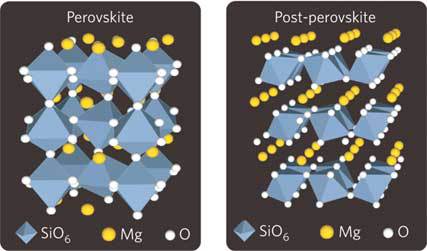What is our planet made out of? (7) Silicate Post-perovskite
What does it look like?

Comparing the silicate perovskite and post-perovskite structures. Picture by K. Hirose.
What is it?
Just before you reach the core of the Earth (where things start to get very strange) there is an area known as the 'ultra-low velocity zone'. The only observations that we have of the deep interior of our planet are how sound waves, generated by earthquakes, move through it. That's how the transitions to the minerals that we've outlined so far have been discovered. But for many years what was occurring at the ultra-low velocity zone was a mystery. At this point the sound waves would slow down a great deal, indicating that something had changed in these regions. The discovery came in 2004 that silicate perovskite could transform at this pressure to an even denser 'post-perovskite' structure. The properties of this material have brought new understanding to the depths of our Earth.
Where did the structure come from?
The post-perovskite structure was first discovered by Murakami et al. in 2004. There's a great article about this discovery and its implications here.






